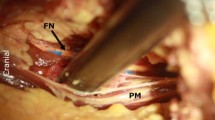Abstract
Purpose
Groin pain is one of the complications after TVT-O procedure. The aim was to examine the position and safety of the tape after TVT-O procedure.
Methods
We inserted TVT-O in 14 formalin-embalmed bodies with legs malpositioned (group 1) and in 5 fresh-frozen bodies with legs malpositioned (group 2) and in 5 fresh-frozen bodies with legs correctly positioned (group 3). After dissection distances from the branches of obturator nerve were measured.
Results
In group 1, the mean distance from the anterior branch of the obturator nerve was 8.6 mm on the left, 7.1 mm on the right. Mean distance from the posterior branch of the obturator nerve was 8.4 mm on the left, 8.9 mm on the right. In group 2, the mean distance from the anterior branch of the obturator nerve was 8.0 mm on the left, 8.0 mm on the right. Mean distance from the posterior branch of the obturator nerve was 5.0 mm on the left, 8.00 mm on the right. In group 3, the mean distance from the anterior branch of the obturator nerve was 24 mm on the left, 23 mm on the right. Mean distance from the posterior branch of the obturator nerve was 23 mm on the left, 23 mm on the right. Statistical analysis was performed with confirmation of significant difference between group of bodies with legs positioned correctly and other groups with malpositioned legs.
Conclusions
The position of the legs is crucial for correct placement of TVT-O.

Similar content being viewed by others
References
Ulmsten U, Petros P (1995) Intravaginal slingplasty (ivs): an ambulatory surgical procedure for treatment of female urinary incontinence. Scand J Urol Nephrol 29(1):75–82
Karram MM, Segal JL, Vassallo BJ, Kleeman SD (2003) Complications and untoward effects of the tension-free vaginal tape procedure. Obstet Gynecol 101(5):929–932. doi:10.1016/s0029-7844(03)00122-4
Nilsson CG, Palva K, Rezapour M, Falconer C (2008) Eleven years prospective follow-up of the tension-free vaginal tape procedure for treatment of stress urinary incontinence. Int Urogynecol J Pelvic Floor Dysfunct 19(8):1043–1047
Cody J, Wyness L, Wallace S, Glazener C, Kilonzo M, Stearns S, McCormack K, Vale L, Grant A (2003) Systematic review of the clinical effectiveness and cost-effectiveness of tension-free vaginal tape for treatment of urinary stress incontinence. Health Technol Assess 7(21):iii, 1–189
Novara G, Ficarra V, Boscolo-Berto R, Secco S, Cavalleri S, Artibani W (2007) Tension-free midurethral slings in the treatment of female stress urinary incontinence: a systematic review and meta-analysis of randomized controlled trials of effectiveness. Eur Urol 52(3):663–678. doi:10.1016/j.eururo.2007.06.018
Delorme E (2001) Transobturator urethral suspension: mini-invasive procedure in the treatment of stress urinary incontinence in women. Prog Urol 11(6):1306–1313
de Leval J (2003) Novel surgical technique for the treatment of female stress urinary incontinence: transobturator vaginal tape inside-out. Eur Urol 44(6):724–730
Achtari C, McKenzie BJ, Hiscock R, Rosamilia A, Schierlitz L, Briggs CA, Dwyer PL (2006) Anatomical study of the obturator foramen and dorsal nerve of the clitoris and their relationship to minimally invasive slings. Int Urogynecol J Pelvic Floor Dysfunct 17(4):330–334
Hazewinkel MH, Hinoul P, Roovers JP (2009) Persistent groin pain following a trans-obturator sling procedure for stress urinary incontinence: a diagnostic and therapeutic challenge. Int Urogynecol J Pelvic Floor Dysfunct 20(3):363–365. doi:10.1007/s00192-008-0714-8
Wang W, Zhu L, Lang J (2009) Transobturator tape procedure versus tension-free vaginal tape for treatment of stress urinary incontinence. Int J Gynaecol Obstet 104(2):113–116. doi:10.1016/j.ijgo.2008.09.013
Hinoul P, Vanormelingen L, Roovers JP, de Jonge E, Smajda S (2007) Anatomical variability in the trajectory of the inside-out transobturator vaginal tape technique (TVT-O). Int Urogynecol J Pelvic Floor Dysfunct 18(10):1201–1206
Meschia M, Bertozzi R, Pifarotti P, Baccichet R, Bernasconi F, Guercio E, Magatti F, Minini G (2007) Peri-operative morbidity and early results of a randomised trial comparing TVT and TVT-O. Int Urogynecol J Pelvic Floor Dysfunct 18(11):1257–1261. doi:10.1007/s00192-007-0334-8
Lim J, Cornish A, Carey MP (2006) Clinical and quality-of-life outcomes in women treated by the TVT-O procedure. BJOG 113(11):1315–1320. doi:10.1111/j.1471-0528.2006.01095.x
Roth TM (2007) Management of persistent groin pain after transobturator slings. Int Urogynecol J Pelvic Floor Dysfunct 18(11):1371–1373. doi:10.1007/s00192-007-0365-1
Acknowledgments
I would like to thank to I. Vítková MD, Chief of Institute of Pathology of the First Faculty of Medicine and General Teaching Hospital, for allowing us to perform research at the Institute of Pathology, for scheduling the dissections and coping with our demands. This study was supported by the Internal Grant Agency of The Ministry of Health of the Czech Republic, grant NS 10586-3/2009, GIGH-0651-00-3-223 and by project of The Ministry of Education, Youth and Sports VZ 0021620806.
Conflict of interest
Martan A. is perceptor of Gynecare.
Author information
Authors and Affiliations
Corresponding author
Rights and permissions
About this article
Cite this article
Hubka, P., Nanka, O., Martan, A. et al. Anatomical study of position of the TVT-O to the obturator nerve influenced by the position of the legs during the procedure: based upon findings at formalin-embalmed and fresh-frozen bodies. Arch Gynecol Obstet 284, 901–905 (2011). https://doi.org/10.1007/s00404-010-1775-8
Received:
Accepted:
Published:
Issue Date:
DOI: https://doi.org/10.1007/s00404-010-1775-8




